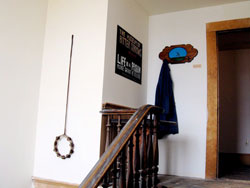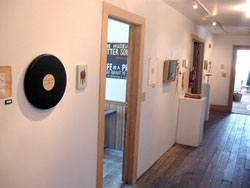The Museum of Bitter Sorrows entryway.
St. Mary's Art Center. June 2010
The Museum of Bitter Sorrows . Central hallway installation view. St. Mary's Art Center. June 2010
CCAI | St. Mary's Art Center Artist In Residency|Exhibition Project: Scott MacLeod: “The Museum of Bitter Sorrows presents
'Life Is A Prison, Please Grant Me Release'”
CCAI Notes: The Capital City Arts Initiative is honored to collaborate with St. Mary’s Art Center on Scott MacLeod’s spring 2010 residency and exhibition. In conjunction with the project, arts and film writer Pam Grady drafted the catalog essay below. CCAI extends appreciations to Pam and Scott and all involved in the project.
Jon Winet
Curator
June 2010
__________________________
“The Museum of Bitter Sorrows presents
'Life Is A Prison, Please Grant Me Release'”
THE Virginia City boomtown literally went boom on a summer's night in 1873 when a potent combination of dynamite and nitroglycerine blew apart a rooming house. Among those killed in the blast was Major General Jacob L. Van Bokkelen, who sold explosives to the miners working the Comstock Lode. His fatal decision to store his inventory under his bed is a minor tragedy in the history of the Wild West, but it is the type of small disaster that engages Scott MacLeod and informs his art.
Like the miners and frontiersmen who settled Virginia City, MacLeod—raised in Virginia and all over the world as the son of American Embassy staffers—heeded Horace Greeley's advice to "Go West, young man." He eventually settled into the urban milieu of the San Francisco Bay Area, but before moving to California, he lived for a time in Colorado, Utah and the bleak high desert of southern Wyoming. It was an introduction to the wilderness, wide-open spaces, pioneering spirit, and mythology of the West.
MacLeod is a versatile craftsman, as adept at poetry and prose as he is with painting, sculpture, drawing, and installation. He has a knack for employing whatever found objects or materials are at hand, for example, creating fiction out of texts and images clipped from magazines, comic books, and anatomy texts or repurposing household items, such as Mercurochrome, iodine, nail polish, spar varnish, and Liquid Paper for his paintings.
His sculpture — fashioned from cement, wood glue, corncobs and shuttlecocks — is just as unorthodox, but it is in the arena of installation that MacLeod's work is most striking. An exhibit preparator in art and history museums, as well as a performance artist, he brings an expert eye and a showman's perspective to the gallery. For his St. Mary's Art Center installation, MacLeod turns to the history of the tragic and accidental: Victoria Era medical texts, photos and etchings of natural disasters, Russian prison tattoos, the high lonesome bluegrass of Appalachia, and found personal diaries of the dead and insane.
The effect is completely immersive, drawing the visitor into an enigmatic universe that offers clues and suggests questions but delivers no definitive answers. MacLeod creates mysteries. Something has happened in this space, perhaps only five minutes ago or in the case of St. Mary's, perhaps 125 years ago. The spectators are invited to assess the objects, debris, and wreckage that fill the room and draw their own conclusions.
Most galleries offer MacLeod space and white walls within which he builds his installations. Virginia City and St. Mary's Art Center provide something more. He is an artist who identifies with the strain of American existentialism that reaches back to Nathaniel Hawthorne and Herman Melville; who appreciates traditional country music's melancholy tales; and who is fascinated by the strain of cataclysm that runs through U.S. history: the Civil War, the 1871 Chicago Fire, and the Great Depression, as well as the natural calamities of earthquakes, floods, and drought.
Long before he was invited to St. Mary's Art Center, MacLeod began applying his interest in American history, and particularly to those years of ever-westward conquest, 1750 to 1880, to his art. He is enthralled by the iconography of the frontier, such as axes, tree stumps, log cabins, and moose. In MacLeod's hands, these normally benign symbols of America's past take on an ominous aspect. In one series of paintings and sculpture shown at San Francisco's Soap Gallery in 2009, cabins set in the woods appear peaceful and bucolic at first glance. Upon closer inspection, none of the structures appear solid and some are actually ablaze. There is no shelter; there is no safety.
Virginia City's history is in keeping with MacLeod's vision of Americana. The Comstock beckoned fortune seekers hungry to make a quick killing and so did the town's gambling halls. Riches plucked out of the earth could be lost in an instant at the faro table. Bigger perils awaited in the mines where lives could be snuffed out by a cave-in or some other kind of accident in an instant.
"It is always seen as especially tragic (or galling) when people die at work, but there is something especially poignant about the deaths of miners," suggests MacLeod.
Two years after the explosion that killed Van Bokkelen and ripped through several buildings including the Bank of California, a conflagration erupted on October 27, 1875, burning down most of the city. And after the boom, came the bust at the turn of the century, the mines stripped clean of the ore that supported the town. Founded as a subscription hospital for miners on land purchased from Van Bokkelen's estate, St. Mary Louise followed a similar trajectory.
One of MacLeod's favorite musicians is Texan singer-songwriter Roky Erickson whose song "If You Have Ghosts," suggests, "If you have ghosts, you have everything." St. Mary's, with its rich history of serving first the mining community then the area at large in its decades as a county hospital, has plenty of ghosts. The edifice itself spent years as a specter: closed in 1940, damaged by fire, its metal fixtures and fittings stripped for salvage to aid the World War II war effort, and then nearly reduced to a pile of bricks before St. Mary's in the Mountains pastor Father Paul Meinecke suggest that the building could be reborn as an art center.
In St. Mary's with its cadavers, its phantoms, and its historical role as a hospital serving the victims of disasters and other tragedies, both large and small, MacLeod has found fresh inspiration. Virginia City, its history and its rebirth through the celebration and reiteration of its past, provides him with similar inspiration. Where this inspiration ultimately led MacLeod will be left up to visitors to the installation to interpret as they attempt to untangle the mysteries in this "Museum of Bitter Sorrows."
Pam Grady
San Francisco, California
June 2010
Note: Below is a link to views of the exhibition. Photography courtesy of the artist.
“The Museum of Bitter Sorrows presents
'Life Is A Prison, Please Grant Me Release'" Album
revised: June 16, 2010 06:45 PDT [gmt - 08:00]

